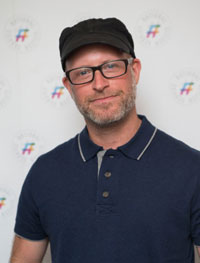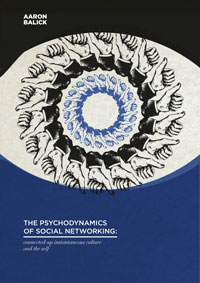Interview by Christina Emanuel
Christina Emanuel: Thank you, Aaron, for your willingness to participate in this interview for the IARPP eNews. And congratulations on the publication of your new book. Could you share a bit about how you became interested in writing about psychoanalysis and social networking?
 Aaron Balick: I have always been interested in applications of psychoanalysis outside the clinic, particularly on popular media like film and TV. Before writing the book I began to notice the growing ubiquity of social media and how it was being used in my own broader (real) social network. I also noticed that psychotherapists were less likely to be engaged in social networking than their patients.
Aaron Balick: I have always been interested in applications of psychoanalysis outside the clinic, particularly on popular media like film and TV. Before writing the book I began to notice the growing ubiquity of social media and how it was being used in my own broader (real) social network. I also noticed that psychotherapists were less likely to be engaged in social networking than their patients.
Around this time I had my first “virtual impingement” – an experience in which the digital world invaded the privacy of my consulting room. The results of a patient’s Google search of my name provoked an intense clinical enactment. After resolving this, I wrote a clinical paper about it (Psychoanalysis, Culture and Society 2012 Vol.17 No.2) in an effort to better understand what happened and share that experience with others in the field.
On reflection it occurred to me that such events were happening all the time between individuals who did not have the luxury of psychotherapy to work out the details. So I decided that rather than writing a clinical book about social networking, I would investigate this cultural phenomena from a relational perspective to better understand its socio-cultural consequences.
What do you hope the reader will take away as the most important message of this book?
Primarily social media provides a technological extension of the self, and because of this, we can use applied psychology to understand it. Unconscious motivations to relate to others, to recognize and be recognized are absolutely central not only to the ubiquitous use of social media, but also to its development and popularity. In this sense, social media is a profoundly human technological development.
Technology has become an object onto which we project both our fears and desires. Because of this, we can lose sight of our thinking and respond out of anxiety or fantasy – producing dystopian or utopian visions instead of clearly articulated critical thinking and working-through.
Historian Melvin Kranzberg is noted for his first rule of technology: “Technology is neither good nor bad, nor is it neutral.” The non-neutrality of social networking rests in the architecture of the sites that mediate our relating to each other, enabling some forms of relating, and disabling others. For example, a social network like Facebook, in which your profile is linked to your real identity, primarily invites outward facing, socially compliant ego expression (Winnicott’s false-self or Jung’s persona) and expression of the ego ideal. An anonymous social network may enable more id-like expression (projection for example), to use a shorthand.
You mention that you have been aware of your own use of social networking when writing this book. How has your use of social media evolved during this period of study and writing?
When I started writing the book, I became more conscious of my use of social networking use in an effort to be a reflexive researcher drawing on some principles of auto-ethnography. I already had a private Facebook account, but I felt I needed to play around on Twitter too, to get a closer understanding of what it was all about – it has been really enlightening, and fun too.
Therapists who choose to tweet need to do so ethically and thoughtfully (more here: http://www.mindswork.co.uk/wpblog/should-shrinks-tweet-public-personas-in-the-context-of-private-work/).
The theories I propose about recognition deployed by social media as being “relational lite” is certainly something I experience myself. Bits of recognition achieved over social networks are like relational donuts – tasty treats, but ultimately unsatisfying. In all honesty, I enjoy donuts (both kinds), and struggle equally to know how many is enough. Mobile technology enables the donut shop to be in your pocket 24 hours a day, and I do find that temptation a challenge (my partner would agree).
Many psychoanalysts are understandably worried about their online reputations and their privacy. What advice do you have for those of us interested in managing these?
There is a lot of anxiety amongst practitioners about their potential exposure via online presence. Unfortunately many have responded to this anxiety by keeping their heads down, feeling like the less they know, the better, when of course the opposite is true. I recommend that all clinicians think through their own “digital policy”. Some may choose to make this explicit and share it with their patients at intake; others (like myself) put it on their website and ask patients to familiarize themselves with it; and some will choose to just formulate a policy in their minds.
Each policy will be individualized but primarily they should deal with how to keep the therapeutic relationship “in the room.” For example, how to deal with clinical material sent via email, which not only extends the therapeutic relationship outside the room, but may also compromise confidentiality by way of viruses or accidental release. It should make clear that the therapist will not engage with patients over social networks, and request that if there are any issues raised by information gained online, it’s best discussed in person.
While one cannot write a policy to cover every eventuality, on can set a framework that deals knowingly with the virtual world.
 What response have you received upon the publication of your book? In particular, I’m curious to know how it has affected your clinical relationships.
What response have you received upon the publication of your book? In particular, I’m curious to know how it has affected your clinical relationships.
The greatest response to the book has been from psychotherapists who have welcomed a thoughtful psychoanalytic approach to this complex and difficult phenomenon. Additionally, people in the tech industry have been extremely interested in my work as well. While there is a great deal of (experimental) psychology in the tech sector, it is not depth psychology. When confronted with dynamic psychology, interpersonal human motivation, and meaning making, the techies eat it up because they can relate to it. I also get a certain mischievous kick out of dropping Freud into my talks with this demographic; they are often surprised to find that, conceptually at least, some of his turn-of-the-19th-century ideas are applicable to today’s technology.
Since the book is not a clinical study about psychotherapy and the Internet, it has not affected my clinical relationships as far as I can tell. It has, however, changed my professional profile. I have noticed that people tend to conflate my theoretical perspectives on social media with working therapeutically online (email, skype, instant messaging, etc.). Though my research is applicable to this field, people are often surprised to find that most of my clinical work is traditional face-to-face therapy. I do not run an online practice and online therapy is not something I am pursuing in practice.
In your book you demonstrate that social media are changing the way we interact, suggesting further research to understand the psychodynamics of social networking. If you were to conduct such research, what might that look like?
Without a doubt any such research would be qualitative, aiming to access the psychodynamics, emotional states, and meaning-making underlying social networking use. Hence, it would be productive to observe a set of individuals as they engage in social media while enabling an interrogation of the thoughts, feelings, and fantasies that accompany their use.
One can imagine using technology itself to assist in this process, for example, a bubble that pops randomly when individuals are engaged in online activities. It may ask, “What motivated you to engage in this activity?” or “What feelings do you have now that you’ve posted a comment?” Further data could then be collected by way of semi-structured interviews and/or focus groups, and a psychoanalytic approach in relation to non-explicit material could then be employed.
Please tell us a bit about your practice and other writing projects you are working on
It was my hope that this book would crossover and be read by those outside the field of psychotherapy; there is a lot that society as a whole needs to be mindful of in relation to social media use – not just those interested in mental health. I took great pains to explain all my terms so those outside psychoanalysis could benefit from its conclusions.
While there has been some crossover, it hasn’t been nearly as much as I would have liked, and I have found that those outside our field find the psychoanalytic application quite difficult to grasp and apply. So this has been a learning experience for me. I am currently researching another book that I hope to publish more widely that explores the nature of the self 14 years into the 21st century. It will be another application of psychological thinking to culture, but will be written in a less academic style and hopefully appeal to a wider readership. I will continue to address social media and technology, but roam more widely into television, cinema and other media, fundamentally asking what is happening to the self today.
Thank you for taking the time to answer our questions.
Click here for review of The Psychodynamics of Social Networking: Connected-up Instantaneous Culture and the Self in IARPP February Bookshelf
aaron@mindswork.co.uk
Aaron Balick
Mindswork
55 St. John Street
London EC1M 3AN
Contact Phone: 07795 398 627
Web: www.mindswork.co.uk

